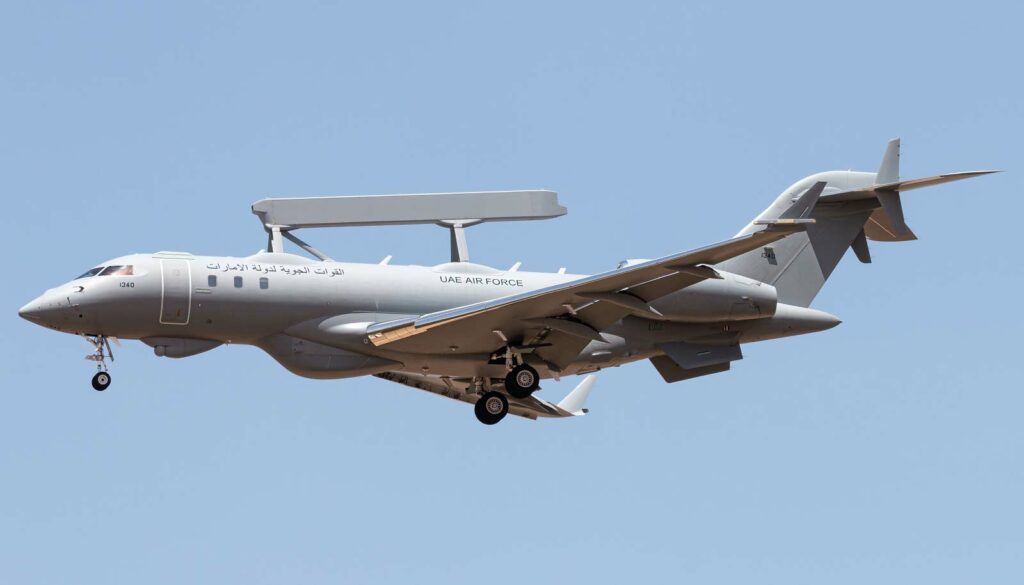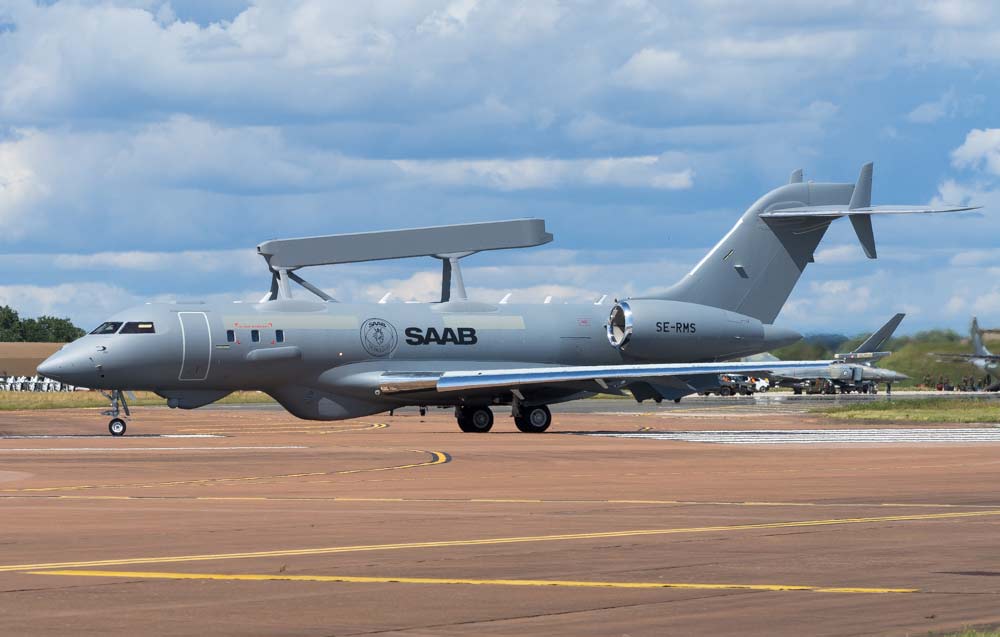The Saab GlobalEye is a multi-role AEW&C aircraft integrating advanced sensors, including the Erieye ER radar, on a Bombardier Global 6000 platform.
The Saab GlobalEye is a multi-role Airborne Early Warning and Control (AEW&C) aircraft developed by Saab. It integrates the Erieye Extended Range (ER) radar and a suite of advanced sensors onto a Bombardier Global 6000/6500 long-range business jet platform. This configuration enables simultaneous air, maritime, and ground surveillance. The Erieye ER radar provides 360-degree coverage with extended detection ranges. Additional sensors include a maritime surveillance radar, electro-optical/infrared (EO/IR) sensor, Electronic Support Measures (ESM)/Electronic Intelligence (ELINT) system, Automatic Identification System (AIS), and Identification Friend or Foe (IFF)/ADS-B. The aircraft is powered by two Rolls-Royce BR710A2-20 turbofan engines, each producing 14,750 pounds (65.6 kN) of thrust, allowing a maximum range of approximately 5,200 nautical miles (9,630 kilometers) and an endurance exceeding 11 hours. GlobalEye’s multi-domain capabilities make it a versatile asset for modern defense forces.
History of the Development of the Saab GlobalEye
In the early 2010s, the global security environment was becoming increasingly complex, with nations facing diverse threats across multiple domains. Traditional surveillance systems, often limited to specific environments, were inadequate for addressing these evolving challenges. Recognizing the need for a more versatile and cost-effective solution, Saab initiated the development of a multi-domain AEW&C system capable of providing comprehensive situational awareness.
In February 2016, Saab announced the launch of the GlobalEye program, aiming to integrate its advanced Erieye ER radar and a suite of sensors onto the Bombardier Global 6000 long-range business jet platform. The selection of the Global 6000 was strategic, offering extended range, high endurance, and the reliability required for demanding surveillance missions.
The primary objective of the GlobalEye program was to deliver a platform capable of simultaneous air, maritime, and ground surveillance, thereby enhancing operational flexibility and reducing the need for multiple specialized aircraft. This approach promised significant cost savings and operational efficiencies for defense forces.
The development phase progressed rapidly, with Saab leveraging its extensive experience in radar technology and systems integration. The first GlobalEye aircraft conducted its maiden flight on March 14, 2018, from Saab’s facility in Linköping, Sweden. This successful flight marked a crucial milestone, demonstrating the viability of the integrated systems and the platform’s performance.
In November 2015, prior to the official launch, Saab secured a contract with the United Arab Emirates (UAE) to deliver a new airborne swing-role surveillance system, which would later be identified as GlobalEye. This partnership underscored the UAE’s commitment to enhancing its surveillance capabilities and Saab’s position as a leading provider of advanced defense solutions.
The GlobalEye does not have a specific NATO reporting name, as it is a relatively recent development and primarily operated by non-NATO countries.
The development of GlobalEye reflects Saab’s proactive approach to addressing emerging security challenges. By anticipating the need for a multi-domain surveillance platform, Saab positioned itself to meet the evolving requirements of modern defense forces.
In summary, the Saab GlobalEye was developed in response to the increasing complexity of global security threats, necessitating a versatile and cost-effective surveillance solution. Through strategic partnerships and leveraging advanced technologies, Saab successfully brought GlobalEye from concept to operational reality, providing defense forces with a powerful tool for maintaining situational awareness across multiple domains.

Design of the Saab GlobalEye
The Saab GlobalEye integrates advanced surveillance systems into the Bombardier Global 6000/6500 aircraft, a long-range business jet known for its reliability and performance. This platform provides the necessary space and endurance for extended surveillance missions.
A key feature of GlobalEye is the Erieye Extended Range (ER) radar, mounted atop the fuselage in a dorsal “plank” configuration. This radar offers 360-degree coverage and extended detection ranges, enabling the aircraft to monitor air and surface targets simultaneously.
In addition to the Erieye ER radar, GlobalEye is equipped with a comprehensive sensor suite, including:
- Maritime Surveillance Radar: Provides high-resolution detection and tracking of surface vessels.
- Electro-Optical/Infrared (EO/IR) Sensor: Offers visual and infrared imaging capabilities for target identification and tracking.
- Electronic Support Measures (ESM)/Electronic Intelligence (ELINT) System: Detects and analyzes electronic emissions, enhancing situational awareness.
- Automatic Identification System (AIS): Assists in identifying and tracking maritime vessels.
- Identification Friend or Foe (IFF)/ADS-B: Facilitates the identification of cooperative aircraft and vehicles.
The integration of these sensors allows GlobalEye to perform multiple surveillance roles simultaneously, enhancing operational flexibility.
GlobalEye’s design incorporates several advantages:
- Multi-Domain Surveillance: Simultaneous monitoring of air, sea, and land domains.
- Extended Range and Endurance: Capable of long-duration missions without the need for aerial refueling.
- Rapid Deployment capability due to its use of the Bombardier Global 6000/6500 platform, known for its ability to operate from standard runways without requiring specialized infrastructure. This ensures that the Saab GlobalEye can be deployed to various locations with minimal logistical support.
One design drawback is the high cost associated with the platform and its advanced systems. While the operational capabilities of GlobalEye justify its price, budget constraints may limit its acquisition to nations with significant defense budgets. Additionally, the complexity of integrating multiple sensors and systems requires a robust maintenance and support infrastructure.
Despite these challenges, the Saab GlobalEye’s design reflects a commitment to delivering unmatched surveillance capabilities in a compact, efficient package. Its advanced sensors, coupled with the reliability of the Bombardier Global platform, position it as a leading solution for modern airborne early warning and control (AEW&C) missions.
Performance of the Saab GlobalEye
The Saab GlobalEye offers superior performance metrics, leveraging the strengths of its platform and integrated systems. Powered by two Rolls-Royce BR710A2-20 turbofan engines, each producing 14,750 pounds (65.6 kN) of thrust, the aircraft achieves a cruising speed of 488 knots (902 km/h) and a maximum operating speed of 516 knots (956 km/h). Its service ceiling reaches 41,000 feet (12,500 meters), allowing it to operate above commercial air traffic and environmental obstacles.
The aircraft boasts a maximum range of 5,200 nautical miles (9,630 kilometers), enabling extended operations over large areas. Its endurance exceeds 11 hours, allowing continuous surveillance missions without the need for refueling. These capabilities make the GlobalEye ideal for long-duration missions, such as monitoring vast oceanic regions or remote land borders.
The Erieye ER radar, a key component of GlobalEye’s performance, provides 360-degree coverage with a detection range of over 400 kilometers (248 miles). It can simultaneously track airborne, maritime, and ground targets, offering exceptional situational awareness. The radar’s advanced signal processing ensures reliable detection even in challenging environments, such as areas with dense clutter or electronic interference.
Additional sensors, including the maritime surveillance radar and EO/IR systems, enhance the aircraft’s versatility. The maritime radar is capable of detecting small vessels at long ranges, while the EO/IR sensors provide high-resolution imagery for target identification. These systems enable GlobalEye to adapt to diverse operational scenarios, from military surveillance to search-and-rescue missions.
Compared to competitors like the E-2D Advanced Hawkeye and Gulfstream G550 AEW&C, the Saab GlobalEye offers a distinct advantage in its multi-domain capabilities. While the E-2D excels in naval operations, its shorter range and limited endurance make it less versatile for extended missions. The G550 AEW&C, while comparable in range and endurance, lacks the integrated maritime and ground surveillance capabilities of the GlobalEye.
The Saab GlobalEye’s performance underscores its value as a force multiplier for modern defense forces. Its ability to operate across multiple domains, coupled with its extended range and endurance, ensures that it remains a critical asset for maintaining situational awareness in complex operational environments.
Variants of the Saab GlobalEye
The Saab GlobalEye currently exists in a single configuration, but its modular design allows for customization based on specific mission requirements. The primary variant is the GlobalEye AEW&C, designed for multi-domain surveillance and equipped with the full suite of advanced sensors, including the Erieye ER radar, maritime surveillance radar, EO/IR systems, and ESM/ELINT capabilities.
Future variants could potentially include specialized configurations focusing on electronic warfare (EW) or signals intelligence (SIGINT). These versions would integrate additional sensors and systems tailored to specific operational needs, such as countering electronic threats or conducting in-depth communications analysis.
The GlobalEye’s adaptability ensures that it can evolve alongside changing mission demands, making it a flexible solution for a wide range of defense applications.

Military Use and Combat of the Saab GlobalEye
The Saab GlobalEye is a multi-role AEW&C platform designed for modern defense needs. Its primary operators include the United Arab Emirates (UAE), which was the launch customer, acquiring three aircraft under a contract signed in 2015. These aircraft have since been integrated into the UAE’s defense forces, supporting air, maritime, and ground surveillance missions.
The GlobalEye’s primary role is to enhance situational awareness by providing real-time intelligence across multiple domains. In military operations, it is used for airborne early warning, tracking hostile aircraft, missiles, and drones at extended ranges. Its advanced radar systems allow it to detect and monitor targets in contested environments, providing critical data to commanders.
In maritime operations, the GlobalEye excels at tracking surface vessels, from large warships to smaller craft used for smuggling or piracy. Its maritime surveillance radar and AIS capabilities enable precise identification and monitoring, supporting naval forces in securing coastal waters and shipping lanes.
The aircraft’s ground surveillance capabilities make it valuable for border security and counterinsurgency operations. Its ability to detect and track ground vehicles, as well as personnel movements, enhances the effectiveness of land-based forces.
The UAE has deployed the GlobalEye in several real-world scenarios, including monitoring regional tensions and conducting border security missions. While specific combat engagements involving the aircraft remain undisclosed, its presence has reportedly enhanced the operational capabilities of UAE forces.
Competing platforms, such as the Boeing E-7 Wedgetail and Gulfstream G550 AEW&C, provide similar capabilities but lack the GlobalEye’s comprehensive multi-domain integration. The Wedgetail focuses primarily on airborne surveillance, while the G550 AEW&C lacks dedicated maritime and ground surveillance features.
The Saab GlobalEye remains in active service, with potential interest from other nations looking to enhance their surveillance capabilities. Its advanced design, coupled with its ability to operate across multiple domains, ensures its continued relevance in modern defense strategies.
The Saab GlobalEye delivers unparalleled multi-domain surveillance capabilities through its integration of advanced sensors and reliable platform design. Its combination of long endurance, extended range, and multi-role versatility ensures its effectiveness in modern defense scenarios. While its cost and complexity may limit its adoption to well-funded defense forces, the GlobalEye’s operational advantages make it a valuable asset for maintaining situational awareness and enhancing mission success.
Back to the Spy Planes section.